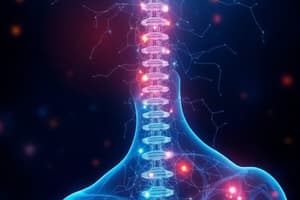Podcast
Questions and Answers
What is the name of the receptors that prevent rupture of muscle?
What is the name of the receptors that prevent rupture of muscle?
- Golgi tendon organs (correct)
- Nociceptors
- Flexor reflex afferents
- Somatic afferents
What type of reflex is an example of polysynaptic spinal reflex?
What type of reflex is an example of polysynaptic spinal reflex?
- Stretch reflex
- Withdrawal reflex (correct)
- Inverse stretch reflex
- Autogenic inhibition
What is the primary function of the withdrawal reflex?
What is the primary function of the withdrawal reflex?
- To protect against painful stimuli (correct)
- To integrate sensory input
- To prevent muscle rupture
- To control voluntary movements
At which level of the nervous system are spinal reflexes integrated?
At which level of the nervous system are spinal reflexes integrated?
What type of afferents are involved in the withdrawal reflex?
What type of afferents are involved in the withdrawal reflex?
What is the term for the integration of sensory input at multiple points in the CNS?
What is the term for the integration of sensory input at multiple points in the CNS?
What is the name of the reflex that prevents rupture of muscle?
What is the name of the reflex that prevents rupture of muscle?
What level of the nervous system controls voluntary movements?
What level of the nervous system controls voluntary movements?
Which of the following reflexes can be initiated by pain receptors?
Which of the following reflexes can be initiated by pain receptors?
What is the function of proprioceptors in reflexes?
What is the function of proprioceptors in reflexes?
What type of reflex is the stretch reflex?
What type of reflex is the stretch reflex?
What is the role of the stretch reflex in maintaining posture?
What is the role of the stretch reflex in maintaining posture?
Which of the following is NOT a function of the stretch reflex?
Which of the following is NOT a function of the stretch reflex?
What is the role of the gamma motor neuron in the stretch reflex?
What is the role of the gamma motor neuron in the stretch reflex?
What is the inverse stretch reflex also known as?
What is the inverse stretch reflex also known as?
What is the result of a strong stretch on a muscle in the Golgi tendon reflex?
What is the result of a strong stretch on a muscle in the Golgi tendon reflex?
What is the primary function of a reflex in the body?
What is the primary function of a reflex in the body?
What is the functional unit of the nervous system for a reflex?
What is the functional unit of the nervous system for a reflex?
Which type of reflexes are processed at the level of the spinal cord?
Which type of reflexes are processed at the level of the spinal cord?
What is the characteristic of a reflex response?
What is the characteristic of a reflex response?
What is the classification of reflexes based on the number of synapses?
What is the classification of reflexes based on the number of synapses?
What is the classification of reflexes based on the location of the integrating center?
What is the classification of reflexes based on the location of the integrating center?
What is the characteristic of a polysynaptic reflex?
What is the characteristic of a polysynaptic reflex?
What is the classification of reflexes based on their origin?
What is the classification of reflexes based on their origin?
Flashcards are hidden until you start studying
Study Notes
Reflexes
- A reflex is an inborn, involuntary, sudden, rapid, and stereotyped response to a stimulus, serving as a survival mechanism.
- Reflexes play a critical role in coordinating body movement and protection by withdrawal.
Reflex Arc
- A reflex arc is the functional unit of the nervous system for a reflex, consisting of 5 components.
Somatosensory & Motor Pathways
- Reflexes involve somatosensory and motor pathways.
Classification of Reflexes
- Reflexes can be classified based on the number of synapses (monosynaptic vs. polysynaptic reflexes).
- Reflexes can also be classified based on the location of the integrating centre (cortical, cerebellar, midbrain, medullary, or spinal reflexes).
- Physiological classification includes flexor reflexes and extensor reflexes.
- Reflexes can be classified as inborn or acquired, and clinically as somatic, visceral (autonomic), or pathologic reflexes.
Spinal Somatic Reflexes and Stretch Receptors
- Four common spinal reflexes involving skeletal muscle as the effector include:
- Stretch reflex
- Golgi tendon reflex
- Withdrawal (flexor) reflex
- Crossed-extensor reflex
- These reflexes can be initiated by proprioceptors or pain receptors (nociceptors).
Stretch Reflex
- A stretch reflex is a monosynaptic reflex that helps maintain muscle tone and posture.
- It is under the influence of discharge from the gamma motor neuron.
- Stretch reflex helps the motor command system in performing voluntary movements.
Golgi-Tendon Reflex or Inverse Stretch Reflex
- An inverse stretch reflex is a polysynaptic reflex that relaxes the muscle in response to a strong stretch.
- This reflex is also known as autogenic inhibition and prevents muscle rupture.
- Receptors involved are Golgi tendon organs (GTO).
Flexor Withdrawal & Crossed Extensor Reflex
- A withdrawal reflex is a protective reflex and a polysynaptic spinal reflex.
- It is elicited by noxious or painful stimulation of skin, subcutaneous tissue, or muscle.
- Receptors involved are nociceptors (type III and IV somatic afferents).
Sensory-Motor Integration
- Sensory input can be integrated at many points in the CNS, with increasing complexity with ascent through the CNS.
- The three levels of the nervous system that control movement are:
- The spinal cord, which integrates spinal reflexes and contains central pattern generators.
- The brain stem and cerebellum, which control postural reflexes and hand and eye movements.
- The cerebral cortex and basal ganglia, which are responsible for voluntary movements.
Studying That Suits You
Use AI to generate personalized quizzes and flashcards to suit your learning preferences.



